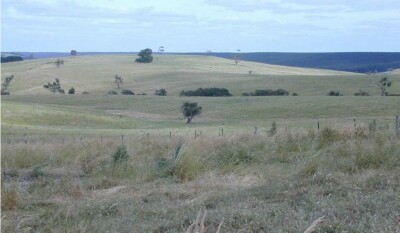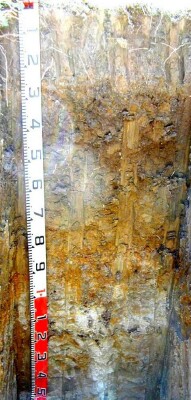ASH98 (plot 4)
| Site: ASH98 (Plot 4) | Land Unit: Digby |
 |
General Land Unit Description: As with the Merino Tablelands land unit, the Digby land unit also occurs on the Cretaceous nonmarine sandstone of the Merino Tablelands. The soils on the Digby land unit differ from the Merino Tablelands land unit as they tend to be slightly more acidic in the top of the subsoil and have more ferruginous nodules (Ferric Brown Chromosols). The division between the two land units is highlighted in recent radiometric imagery. Black Chromosols, Dermosols and Vertosols, similar to the Merino land unit also occur. 2.5 year old Eucalyptus globulus plantation on ex-agricultural land |
Site Description:
| Geology: Cretaceous non-marine sandstone | Landform pattern: Undulating plain |
| Internal drainage: Imperfectly drained |
Soil Profile Morphology
| A1 | 0-30 cm | Dark brown (10YR3/3) clay loam; weak polyhedral structure (20-50 mm) parting to weak granular structure (5-10 mm); very weak consistence when dry; very few medium ferruginous nodules; many very fine macropores; areal porosity 0.2%; many medium roots; abrupt and smooth transition to: |  |
| Subsoil | |||
| B21 | 30-60 cm | Yellowish brown (10YR5/4), medium clay; weak polyhedral structure (20-50 mm); firm consistence when moderately moist; common very fine macropores; areal porosity 0.08%; few very fine roots; diffuse and smooth transition to: | |
| B22 | 60-90 cm | Yellowish brown (10YR5/4) with many medium faint yellowish brown (10YR5/6) mottles, medium heavy clay; weak polyhedral structure (20-50 mm); firm consistence when moderately moist; common very fine macropores; areal porosity 0.08%; few very fine roots; clear and smooth transition to: | |
| B3 | 90-115 cm | Light brownish grey (10YR6/2) with many coarse distinct yellowish brown (10YR5/6) and brownish yellow (10YR6/8) mottles, medium heavy clay; moderate polyhedral structure (20-50 mm) parting to moderate polyhedral structure (10-20 mm); weak consistence when moderately moist; few coarse ferruginous nodules; few very fine macropores; areal porosity 0.5%; few very fine roots; clear and smooth transition to: | |
| C1 | 115-150 cm | Light brownish grey (10YR6/2) with common coarse prominent yellowish brown (10YR5/8) mottles, silty clay; massive structure; weak consistence when moderately moist; many very fine macropores; areal porosity 0.4%; few very fine roots. | |
| 150-210 cm | Fine sandy clay or clayey fine sand. | ||
| 210-310 cm | Grey Miocene mudstones, carbonaceous, live roots to 310 cm in cracks, appears to be an impeding layer although some roots are present. | ||
Notes: The Mudstone layer does not appear to offer a large water holding capacity.
Sampled by: Ian Sargeant, Paul Feikema and Martin Clark (6 December 2000)


